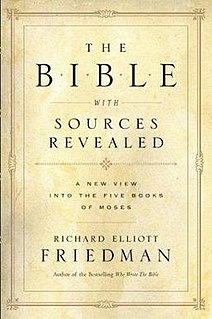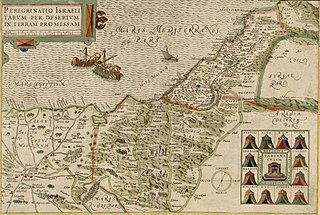 W
WThe documentary hypothesis (DH) is one of the models historically used by biblical scholars to explain the origins and composition of the Torah. More recent models include the supplementary hypothesis and the fragmentary hypothesis. All agree that the Torah is not a unified work from a single author, but is made up of sources combined over many centuries by many hands. These models differ on the nature of these sources and how they were combined.
 W
WTable I gives an overview of the periods and dates ascribed to the various books of the Bible. Tables II, III and IV outline the conclusions of the majority of contemporary scholars on the composition of the Hebrew Bible and the Protestant Old Testament, the deuterocanonical works, and the New Testament.
 W
WThe Bible with Sources Revealed (2003) is a book by American biblical scholar Richard Elliott Friedman dealing with the process by which the five books of the Torah or Pentateuch came to be written. Friedman follows the four-source documentary hypothesis model, but differs significantly from Julius Wellhausen's model in several respects.
 W
WThe Blessing of Jacob is a prophetic poem that appears in Genesis at 49:1–27 and mentions each of Jacob's twelve sons. Genesis presents the poem as the words of Jacob to his sons when Jacob is about to die.
 W
WUmberto Cassuto, also known as Moshe David Cassuto, was a rabbi and biblical scholar.
 W
WThe composition of the Torah was a process that involved multiple authors over an extended period of time. While Jewish tradition holds that all five books were originally written by Moses sometime in the 2nd millennium BCE, by the 17th century leading scholars had rejected Mosaic authorship.
 W
WAccording to the documentary hypothesis, the Elohist is one of four source documents underlying the Torah, together with the Jahwist, the Deuteronomist and the Priestly source. The Elohist is so named because of its pervasive use of the word Elohim to refer to the Israelite god.
 W
WThe Holiness Code is used in biblical criticism to refer to Leviticus chapters 17–26, and is so called due to its highly repeated use of the word Holy. Critical biblical scholars have regarded it as a distinct unit and have noted that the style is noticeably different from the main body of Leviticus. Unlike the remainder of Leviticus, the many laws of the Holiness Code are expressed very closely packed together, and very briefly.
 W
WThe Jahwist, or Yahwist, often abbreviated J, is one of the most widely recognized sources of the Pentateuch (Torah), together with the Deuteronomist and the Priestly source. The existence of the Jahwist is somewhat controversial, with a number of scholars, especially in Europe, denying that it ever existed as a coherent independent document. Nevertheless, many scholars do assume its existence, and date its composition to the period of the Babylonian captivity or perhaps somewhat later. The Jahwist is so named because of its characteristic use of the term Yahweh for God.
 W
WThe Priestly source is perhaps the most widely recognized source underlying the Torah. It is both stylistically and theologically distinct from other material in the Torah, and includes a set of claims that are contradicted by non-Priestly passages and therefore uniquely characteristic: no sacrifice before the institution is ordained by Yahweh (God) at Sinai, the exalted status of Aaron and the priesthood, and the use of the divine title El Shaddai before God reveals his name to Moses, to name a few. In general, the Priestly work is concerned with priestly matters – ritual law, the origins of shrines and rituals, and genealogies – all expressed in a formal, repetitive style. It stresses the rules and rituals of worship, and the crucial role of priests, expanding considerably on the role given to Aaron.
 W
WThe Ritual Decalogue is a list of laws at Exodus 34:11–26. These laws are similar to the Covenant Code and are followed by the phrase "ten commandments". Although the phrase "Ten Commandments" has traditionally been interpreted as referring to a very different set of laws, in Exodus 20:2–17, many scholars believe it instead refers to the Ritual Decalogue found two verses earlier.
 W
WThe Song of the Sea is a poem that appears in the Book of Exodus of the Hebrew Bible, at Exodus 15:1–18. It is followed in verses 20 and 21 by a much shorter song sung by Miriam and the other women. The Song of the Sea was reputedly sung by the Israelites after their crossing the Red Sea in safety, and celebrates the destruction of the Egyptian army during the crossing, and looks forward to the future conquest of Canaan.
 W
WThe Stations of the Exodus are the 42 locations visited by the Israelites following their exodus from Egypt, recorded in Numbers 33, with variations also recorded in the books of Exodus and Deuteronomy.
 W
WIn biblical studies, the supplementary hypothesis proposes that the Pentateuch was derived from a series of direct additions to an existing corpus of work. It serves as a revision to the earlier documentary hypothesis, which proposed that independent and complete narratives were later combined by redactors to create the Pentateuch.
 W
WJulius Wellhausen was a German biblical scholar and orientalist. In the course of his career, he moved from Old Testament research through Islamic studies to New Testament scholarship. Wellhausen contributed to the composition history of the Pentateuch/Torah and studied the formative period of Islam. For the former, he is credited as one of the originators of the documentary hypothesis.